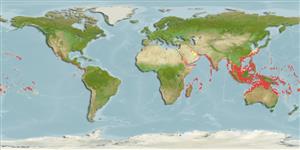Common names from other countries
>
Anguilliformes (Eels and morays) >
Muraenidae (Moray eels) > Muraeninae
Etymology: Gymnothorax: Greek, gymnos = naked + Greek, thorax, -akos = breast (Ref. 45335).
More on author: Lacepède.
Environment: milieu / climate zone / depth range / distribution range
Ökologie
seewasser; brackwasser riff-verbunden; tiefenbereich 1 - 110 m (Ref. 58302). Tropical; 32°N - 28°S
Indo-Pacific: Red Sea and East Africa, including Walters Shoal (Ref. 33390) and Persian Gulf (Ref. 68964) to French Polynesia, north to southern Japan and the Hawaiian Islands, south to the southern Great Barrier Reef. Eastern Central Pacific: Costa Rica and Panama (Ref. 9324).
Length at first maturity / Size / Gewicht / Alter
Maturity: Lm ?, range 77 - ? cm
Max length : 150 cm TL Männchen/unbestimmt; (Ref. 1602)
Kurzbeschreibung
Morphologie | Morphometrie
Rückenflossenstacheln (insgesamt): 0; Rückenflossenweichstrahlen (insgesamt): 0; Afterflossenstacheln 0; Afterflossenweichstrahlen: 0; Wirbelzahl: 126 - 138. Distinctive pattern of light undulating lines and speckles on a dark green background. Snout often yellow (Ref. 30404).
A common species on reef flats among rocks, rubble, or debris and also occurs in lagoons and seaward reefs to depths of 26 m or more. Minimum depth of 1m (Ref. 81209). Cavernicolous (Ref. 8593, 58302). Benthic (Ref. 58302). Nocturnal species that feeds on fishes, octopi, and probably crustaceans. Reported to be an aggressive species and prone to bite. Used in Chinese medicine (Ref. 12166).
Life cycle and mating behavior
Geschlechtsreife | Fortpflanzung | Ablaichen | Eier | Fecundity | Larven
Chen, H.-M., K.-T. Shao and C.T. Chen, 1994. A review of the muraenid eels (Family Muraenidae) from Taiwan with descriptions of twelve new records. Zool. Stud. 33(1):44-64. (Ref. 6934)
IUCN Rote Liste Status (Ref. 130435)
CITES (Ref. 128078)
Not Evaluated
Bedrohung für Menschen
Reports of ciguatera poisoning (Ref. 4690)
Nutzung durch Menschen
Fischereien: weniger kommerziell; Aquarium: Kommerziell
Mehr Information
ReferenzenAquakulturAquakultur ProfilZuchtlinienGenetikElectrophoresesVererbbarkeitKrankheitenVerarbeitungMass conversion
Tools
Zusatzinformationen
Download XML
Internet Quellen
Estimates based on models
Preferred temperature (Ref.
115969): 24.3 - 29, mean 28 (based on 1810 cells).
Phylogenetic diversity index (Ref.
82804): PD
50 = 0.5000 [Uniqueness, from 0.5 = low to 2.0 = high].
Bayesian length-weight: a=0.00065 (0.00041 - 0.00103), b=3.28 (3.15 - 3.41), in cm Total Length, based on LWR estimates for this species & Genus-body shape (Ref.
93245).
Trophic level (Ref.
69278): 3.6 ±0.3 se; based on diet studies.
Widerstandsfähigkeit (Ref.
120179): sehr niedrig, Verdopplung der Population dauert mehr als 14 Jahre. (Preliminary K or Fecundity.).
Fishing Vulnerability (Ref.
59153): Very high vulnerability (90 of 100).
